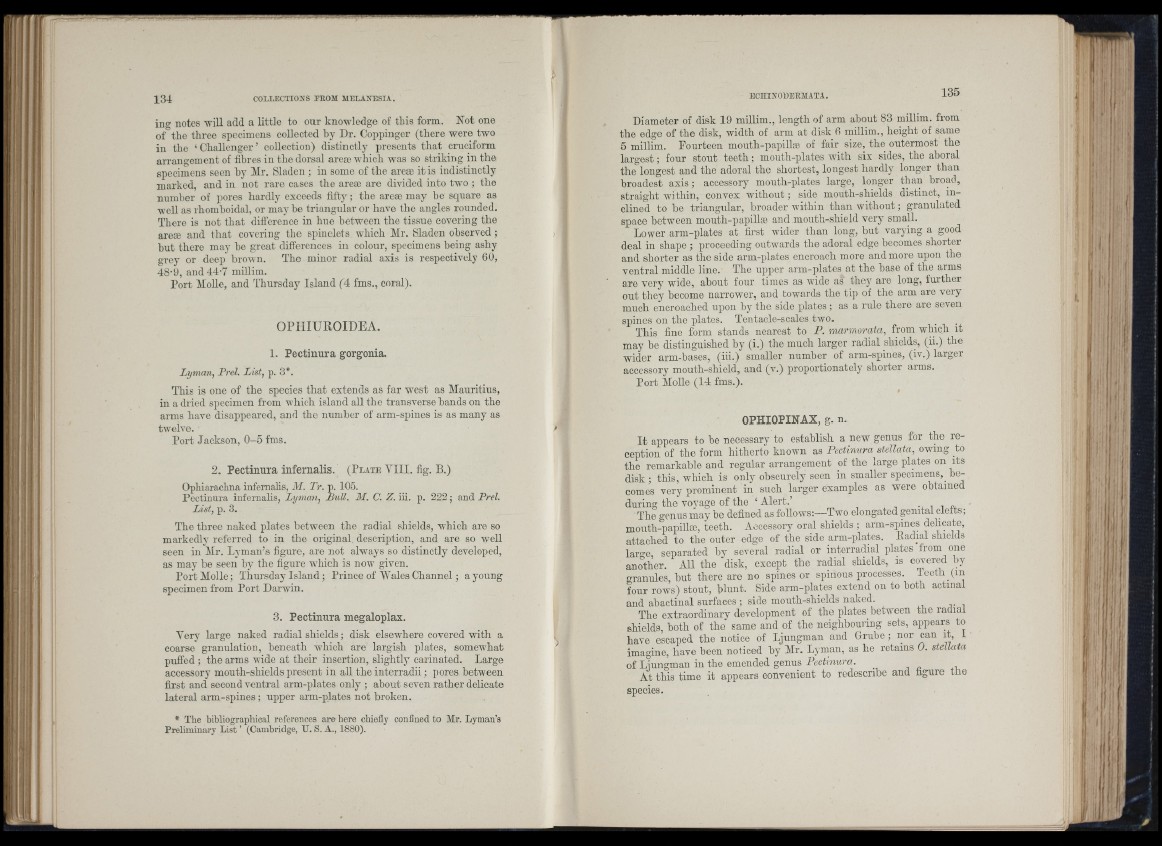
ino- notes will add a little to our knowledge of this form. Not one
oYthe three specimens collected by Dr. Coppinger (there were two
in the ‘ Challenger’ collection) distinctly presents th at cruciform
arrangement of fibres in the dorsal area? which was so striking in the
specimens seen by Mr. Sladen ; in some of the arem it is indistinctly
marked, and in not rare cases the arete are divided into tw o ; the
number of pores hardly exceeds fifty; the arete may be square as
well as rhomboidal, or may he triangular or have the angles rounded.
There is not that difierence in hue between the tissue covering the
area? and th a t covering the spinclets which Mr. Sladen observed ;
but there may he great differences in colour, specimens being ashy
grey or deep brown. Tho minor radial axis is respectively 60,
48-0, and 44-7 millim.
Port Molle, and Thursday Island (4 fms., coral).
OPHIUEOIDEA.
1. Pectinura gorgonia.
Lyman, Prel. List, p. 3*.
This is one of the species th at extends as far ivest as Mauritius,
in a dried specimen from which island all the transverse hands on the
arms have disappeared, and the number of arm-spiues is as many as
twelve.
Port Jackson, 0 -5 fms.
2. Pectinura infernalis. ( P l a t e Y III. fig. B.)
Ophiarachna infernalis, M. Tr. p. 105.
Pectinura infernalis, Lyman, BuU. M. C. Z. iii. p. 222; and Prel.
List, p. 3.
The three naked plates between the radial shields, which are so
markedly referred to in the original description, and are so well
seen in Mr. Lyman’s figure, are not always so distinctly developed,
as may he seen by the figure which is now given.
Port Molle; Thursday Isla n d ; Prince of Wales Channel; a young
specimen from Port Darwin.
3. Pectinura megaloplax.
Very large naked radial shields; disk elsewhere covered with a
coarse granulation, beneath which are largish plates, somewhat
puffed ; the arms wide at their insertion, slightly carinated. Large
accessory mouth-shields present in all the in terrad ii; pores between
first and second ventral arm-plates only ; about seven rather delicate
lateral arm-spines ; upper arm-plates not broken.
* The bibliographical references are’ here chiefly confined to Mr. Lyman’s
Preliminary List ’ (Cambridge, U. S. A., 1880).
Diameter of disk 19 millim., length of arm about 83 millim. from
the edge of the disk, width of arm at disk 6 millim., height of same
5 millim. Fourteen month-papillæ of fair size, the outermost the
largest ; four stout teeth ; mouth-plates with six sides, the aboral
the longest and the adorai the shortest, longest hardly longer than
broadest axis; accessory mouth-plates large, longer than broad,
straight within, convex without; side mouth-shields di.stinct, inclined
to he triangular, broader within than without ; granulated
space between mouth-papilla? and mouth-shield very small.
Lower arm-plates at first wider than long, hut varying a good
deal in shape ; proceeding outwards the adorai edge becomes shorter
and shorter as the side arm-plates encroach more and more upon the
ventral middle line. The upper arm-plates at the base of the arms
aro very wide, about four times as wide as they aro long, further
out they become narrower, and towards the tip of the arm are very
much encroached upon by the side plates ; as a rule there are seven
spines on the plates. Tentacle-scales two.
This fine form stands nearest to P. marmorata, from which it
may be distinguished by (i.) the much larger radial shields, (ii.) the
wider arm-bases, (ill.) smaller number of arm-spines, (iv.) larger
accessory mouth-shield, and (v.) proportionately shorter arms.
Port Molle (14 fms.).
OPHIOPINAX, g. n.
I t appears to he necessary to establish a new genus for the reception
of the form hitherto known as Pectinura stellata, owing to
the remarkable and regular arrangement of the large plates on its
disk ; this, which is only obscurely seen in smaller specimens,_ becomes
very prominent in such larger examples as were obtained
during the voyage of the ‘ Alert.’ •, i i
The o-enns may be defined as follows:—Two elongated genital cleits;
moiith-mpilla?, teeth. Accessory oral shields ; arm-spines delicate,
attached to the outer edge of the side arm-plates. Badial shields
large, separated by several radial or interradial plates from one
another. All the disk, except the radial shields, is covered by
granules, but there are no spines or spinous processes. Teeth (m
four rows) stout, blunt. Side arm-plates extend on to both actinal
a n d a h a c t i n a l surfaces ; side month-shields naked.
The extraordinary development of the plates between the radial
shields, both of the same and of the neighbouring sets, appears to
have escaped the notice of Ljnngnian and Grube ; nor can it, 1
imagine, have been noticed by Mr. Lyman, as he retains 0. stellata
of Liungman in the emended genus Pectinura. _
At this time it appears convenient to redescribe and hgure the
speciea.
; ; i' 1
’ i *
I I I